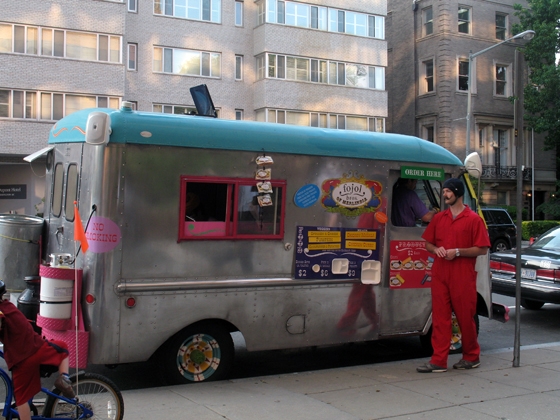In Washington DC, like many metro areas across the countries, food trucks have edged out cupcakeries as the next trendy thing. It seems like every week, another one pops up- fortunately the folks over at Food Truck Fiesta have created a real-time automated food truck tracker to keep up with all the taco-toting trailers, showing the breadth of options available for decent street meat.
What’s the deal with this phenomenon? Let’s look at it from the customer’s perspective first. There is definitely an intangible “cool” factor that accompanies buying food from a big, loudly painted truck, from the sidewalk. Customers also appreciate supporting local businesses, and the roving nature of street meat creates a unique situation where limited- or unpredictable- supply drives demand.
What about the food trucks- is the one-off roaming storefront a successful business model? In this bloggers humble opinion, the food truck business is not scalable enough to be viable in the long term, but food trucks can be used successfully as an extension of a brand (see sweetgreen’s “sweetflow mobile”).
I’ll break down the business model to explain further.
There are certain fixed costs and variable operating costs incurred to open and run a food truck business (disclaimer: the author once dabbled in the mobile food industry- see “Burrito Box”). Here’s a quick and dirty run down.
Fixed Costs
- A truck from which to run the operation. I received many estimates from manufacturers across the country, and even second-hand trucks can go for upwards of $100k
- Storage. City laws hold food trucks to adequately high standards of health, and require them to be stored at a registered depot or restaurant every night in order to store, prepare and cook food; empty trash; and get clean water. These depots charge anywhere between $300-800 per month to host food trucks
- Permits and insurance: to be fair, registering a food truck is less of a hassle than opening a full-scale restaurant, but there is still a lot of red tape to cut through. Insurance isn’t required, but if you’re driving around in a two-ton truck full of hot grease, curry, and whatever else you’re shlepping around, you be a fool not to buy it.
Operating Costs
- Fuel. If you’re pumping out hundreds of meals per week, expect to become intimately familiar with your local propane dealer. Additionally, these giant trucks are no Prius, and expect to get no more than 12mpg while navigating those mean city streets
- Employees. Here’s a quick list of tasks undertaken on a daily basis: supply runs, loading up the cart (ice, food, supplies), driving, food preparation, serving customers, unloading cart, cleaning. A superman crew of two might be able to do all the aforementioned tasks, but realistically if you have a solid stream of customers throughout the day, 3-5 total employees are required. Even at minimum wage (shame on you), you’re looking at daily staffing expenses of at least $200
- FOOD. Obviously, this is a hugely variable expense, and,depending on the type of food served, needs to be managed very closely through a tight inventory control system. It doesn’t matter if you sell 100 meals a day- if you cook food to feed 200 and have to chunk the rest, say goodbye to your margins
- Marketing. In this day and age, clever Tweeting and a solid website are often all you need to get started- plus if you have a friend or two in the media, call in those favors they owe you.
Still interested in opening you’re very own whoopee pie and homemade granola truck? Good for you. Now that we’ve examined the cost side of the equation, let’s examine revenues.
Food, snack and drink sales will account for 99% of all sales for 99% of all food trucks. A few clever blokes might sell advertising space on their truck (what a great idea) or sell merchandising, but those are not the main revenue streams. When will you operate- breakfast, lunch, dinner, late night, or some combination?
If you’re charging $5-10 per meal and $1-2 per snack and/or drink, it’s easy to play around with numbers and blow out some revenue predictions. Of course, the drinks will be the highest margin product, but your food should drive customers (hi Pun!) to your establishment .
Ok so now for some bad news. This is a highly seasonal business that caters to a very flippant crowd. In the DC area, we receive precipitation (>.01 in) more than 1/3rd days of the year; expect sales to drop significantly anytime customers have to suffer extreme cold, heat, or wetness to consume your goods.
So let’s wrap this burrito up. Why do I think this isn’t a great model as a stand alone? Because it’s so difficult to scale; there is a risk of market saturation, and building a fleet of trucks is neither practical nor sustainable should the local craze for insert local craze here run out.
As a marketing tool, however, I think food trucks are a solid investment. The iconic RedBull car is an interesting manifestation, and I’m sure DC’s sweetgreen truck has introduced hundreds of Washingtonians to the brand.
Regardless of my position on the food truck business model, I am a loud advocate of the street meat scene and encourage you to venture out to the curb!
